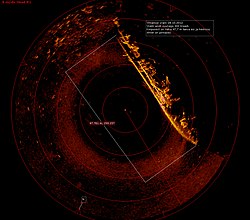Sonar
Sonar is a machine that uses underwater sound waves to find other objects in the sea. A sonar can work by sending out sound and listening for echoes (active sonar), like a radar, or by listening for sound made by the object it is trying to find (passive sonar).[1]
The basic parts of an active sonar are:
- the transmitter creates the sound waves.
- the hydrophone or hydrophone array converts the sound waves into electricity.
The first use of passive sonar was in 1490 by Leonardo da Vinci,[2] when he put a tube onto water and listened. Active sonar was first used in 1917 by Paul Langevin. The word SONAR was created during the Second World War as an acronym for Sound Navigation and Ranging.[3] This acronym replaced the British acronym ASDIC. The word is now thought by many people as a regular word, no longer as an acronym.
Sonar Media
French F70 type frigates (here, La Motte-Picquet) are fitted with VDS (variable depth sonar) type DUBV43 or DUBV43C towed sonars.
A sonar image of the Soviet Navy minesweeper T-297, formerly the Latvian Virsaitis, which was shipwrecked in December 1941 in the Gulf of Finland.
AN/AQS-13 dipping sonar deployed from an H-3 Sea King
References
- ↑ Wragg, David W. (1973). A Dictionary of Aviation (first ed.). Osprey. p. 245. ISBN 9780850451634.
- ↑ Fahy, Frank (1998). Fundamentals of noise and vibration. John Gerard Walker. Taylor & Francis. p. 375. ISBN 978-0-419-24180-5.
- ↑ "What is sonar?". oceanservice.noaa.gov. 2013. Retrieved 30 December 2013.
| Wikimedia Commons has media related to Lua error in Module:Commons_link at line 62: attempt to index field 'wikibase' (a nil value).. |









